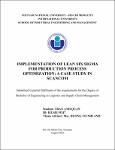| dc.description.abstract | Purpose – The purpose of this paper is to share the experience and knowledge of
optimizing production process by implementing Lean Six Sigma (LSS) in an academic
manner.
Design/methodology/approach – The study employs various Lean Six Sigma tools,
including OEE to evaluate machine efficiency, Value Stream Mapping and Yamazumi for
cycle time analysis, Pareto charts, and other root cause analysis methods for defect analysis.
Findings – After implementing Lean Six Sigma (LSS) methodologies in the
Scancom production line, the Overall Equipment Effectiveness (OEE) increased by 25%,
resulting in a notable enhancement of machine efficiency. Additionally, cycle time per
worker was reduced by 6%, leading to a more streamlined production process. Defects
were reduced by 45%, significantly improving product quality, and the production capacity
witnessed a remarkable rise of 6%.
Practical Implications – This paper is conducted to eliminate or reduce the
inefficiency in the production process of Scancom. From a pure practical standpoint, the
paper implements the method and tools of LSS in detail and effectively as a powerful
business strategy and problem-solving methodology for all industrial sectors
Originality/value – Originality/Value: This thesis stands out for its unique approach
in considering not only the optimization of production processes through Lean Six Sigma
(LSS) but also the careful analysis of cycle time reduction to enhance productivity while
avoiding overloading the production line. By addressing the delicate balance between
increased production capacity and maintaining efficiency, this study offers valuable
insights for industrial sectors seeking sustainable improvements. As industries continue to
strive for greater efficiency without compromising quality, this thesis serves as a strong
reference and guide for future implementations of LSS to achieve productivity gains while
ensuring optimal performance and resource utilization. | en_US |


